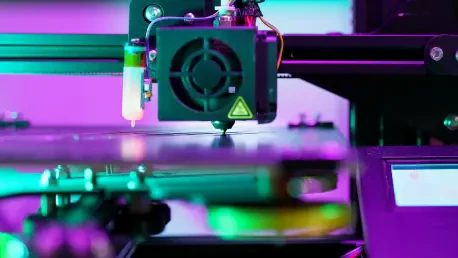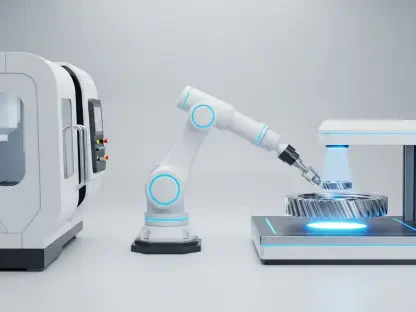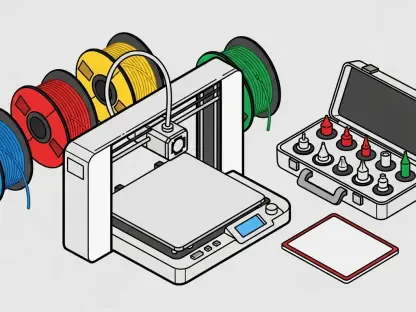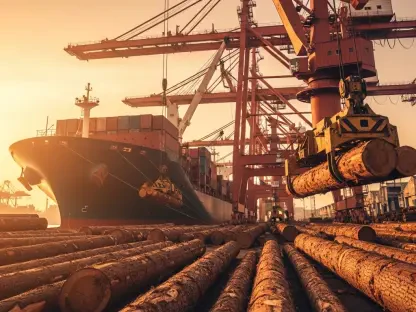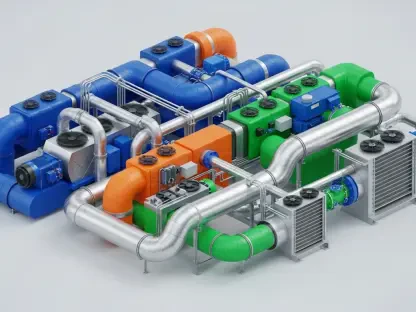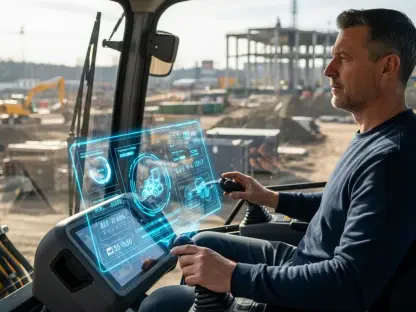The manufacturing sector is teetering on the edge of a monumental shift, propelled by groundbreaking technologies that promise to redefine production processes across industries. Innovations like artificial intelligence (AI), robotics, the Industrial Internet of Things (IIoT), and additive manufacturing (3D printing) are no longer futuristic concepts but tangible forces driving efficiency, slashing operational costs, and enhancing product quality. According to a recent industry report, the global market for emerging technologies in manufacturing is projected to surge from $209.30 million in 2024 to an impressive $1,145.53 million by 2034, achieving a remarkable compound annual growth rate (CAGR) of 18.53%. This staggering growth underscores a future where smart factories and digital transformation become the backbone of industrial operations. As industries such as automotive, aerospace, and healthcare embrace these advancements, the ripple effects are already visible in streamlined workflows and sustainable practices. The journey to 2034 raises critical questions about the depth and speed of this transformation, setting the stage for a closer examination of the forces at play.
The Dawn of Industry 4.0 and Smart Factories
The advent of Industry 4.0 marks a pivotal era in manufacturing, characterized by the rise of smart factories that integrate cutting-edge technologies to revolutionize production. At the core of this movement are AI, IIoT, and advanced robotics, which enable automation and real-time data exchange across interconnected systems. These factories can monitor and adjust operations instantaneously, minimizing downtime and maximizing productivity. The vision for 2034 sees most manufacturing facilities operating with such seamless connectivity, fundamentally altering how goods are conceptualized, designed, and produced. This digital overhaul not only enhances operational efficiency but also paves the way for innovative business models that prioritize adaptability and precision in an increasingly competitive global market.
Another driving force within Industry 4.0 is the growing emphasis on sustainability, as manufacturers align with environmental, social, and governance (ESG) objectives. Green technologies, including energy-efficient machinery and 3D printing, are being adopted to reduce waste and lower carbon footprints. Regulatory pressures and consumer expectations are pushing companies to integrate these eco-friendly solutions into their core strategies. By 2034, the fusion of digitalization with sustainable practices is expected to become a standard, ensuring that efficiency does not come at the expense of environmental responsibility. This dual focus highlights a future where technology serves as a tool for both progress and planetary stewardship.
Technologies Shaping the Future of Production
Among the myriad innovations propelling manufacturing forward, digital twins stand out as a transformative tool, offering virtual simulations of physical systems for real-time analysis and predictive maintenance. These digital replicas allow companies to test scenarios, optimize supply chains, and prevent equipment failures before they occur, saving significant time and resources. AI and machine learning (ML) complement this by providing instantaneous insights and process enhancements, driving precision in production lines. Looking ahead to 2034, these technologies are anticipated to be ubiquitous, enabling manufacturers to achieve levels of customization and operational accuracy that were once unimaginable, thereby redefining industry standards.
Robotics and additive manufacturing also play pivotal roles in this technological evolution, reshaping how products are made. Advanced robots execute intricate tasks with unmatched speed and consistency, while 3D printing facilitates bespoke production with minimal material waste. Leading companies in sectors like automotive are already harnessing these tools—consider the AI-powered analytics optimizing factory operations or digital twins refining assembly processes. As costs decrease and accessibility improves over the coming years, even smaller manufacturers are likely to adopt these innovations, democratizing access to cutting-edge capabilities. By 2034, the widespread integration of such technologies could level the competitive landscape, allowing diverse players to innovate and thrive.
Global Adoption Trends and Regional Variations
The global adoption of emerging technologies in manufacturing reveals a varied landscape, with distinct regional dynamics influencing the pace of transformation. North America and Europe currently lead the charge, bolstered by substantial investments in smart factory infrastructure and a long-standing industrial foundation. These regions benefit from early adoption of AI, robotics, and IIoT, positioning them as frontrunners in setting industry benchmarks. However, challenges such as high implementation costs and integration complexities with legacy systems persist, requiring strategic solutions to maintain momentum. By 2034, these areas are expected to solidify their dominance, driven by continuous innovation and robust policy support that fosters technological advancement.
In contrast, the Asia-Pacific region is emerging as a powerhouse of growth, fueled by rapid industrial expansion in countries like China and India, particularly in electronics and automotive production. Government initiatives and funding are accelerating the adoption of automation and sustainable practices, positioning this region to potentially outpace others by 2034. Despite this promise, barriers such as workforce skill shortages and financial constraints for smaller enterprises could slow progress if not addressed. The disparity in adoption rates across regions underscores the importance of tailored strategies that account for local economic and cultural contexts, ensuring that the benefits of technological transformation are realized globally.
Challenges and Opportunities on the Horizon
While the trajectory of emerging technologies in manufacturing is overwhelmingly positive, significant challenges loom that could temper the speed of adoption. High upfront costs for deploying advanced systems like AI and digital twins often deter smaller manufacturers, creating an uneven playing field. Additionally, integrating these innovations with outdated infrastructure poses technical hurdles, requiring substantial investment in upgrades. Workforce readiness remains another critical issue, as many employees lack the digital skills needed to operate in tech-centric environments. Addressing these barriers through targeted training programs and financial incentives will be essential to ensure broader participation in this industrial shift by 2034.
Yet, amidst these challenges lie vast opportunities for growth and innovation that could redefine manufacturing’s future. The expansion of predictive maintenance through digital twins offers a pathway to minimize downtime and enhance operational reliability. Flexible production systems enabled by 3D printing and robotics also cater to the rising demand for customized products, opening new market segments. By 2034, the industry could see a surge in collaborative efforts between technology providers and manufacturers to overcome existing hurdles, fostering an ecosystem where efficiency and adaptability are paramount. Capitalizing on these opportunities will require a concerted focus on scalability and skill development to fully harness the potential of emerging technologies.
Reflecting on a Tech-Driven Manufacturing Legacy
Looking back, the journey of emerging technologies in manufacturing was marked by a relentless drive toward innovation, as tools like AI, robotics, and digital twins reshaped the industrial landscape. By 2034, the sector had evolved into a realm of smart factories and sustainable practices, driven by a market that grew to over $1.1 billion. Challenges such as high costs and skill gaps were met with strategic solutions, from government-backed training initiatives to corporate investments in accessible tech. The regional disparities in adoption, once stark, had begun to narrow through tailored policies and collaborative efforts. Moving forward, the focus should shift to ensuring equitable access to these advancements, prioritizing smaller manufacturers through subsidies and partnerships. Continuous investment in workforce education will also be crucial to sustain this momentum, while fostering global cooperation could further accelerate sustainable innovation, cementing a legacy of progress for future generations.
